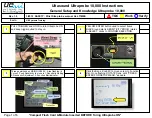
23
A M P1B1 , A M P1C 2 , A M P1C 3 Com pac t Powe r a nd E ne rg y M ete r
Installation
Disconnect power prior to installation.
Reinstall any covers that are displaced during the
installation before powering the unit.
Mount the meter in an appropriate electrical enclosure
near equipment to be monitored.
Do not install on the load side of a Variable Frequency
Drive (VFD).
DIN Rail Mounting
1. Attach mounting clips to the underside of the housing by
sliding them into the slots from the inside. The stopping pegs
must face the housing, and the outside edge of the clip must be
flush with the outside edge of the housing.
2. Snap the clips onto the DIN rail. See diagram of the underside
of the meter. (Figure 7).
3. To prevent horizontal shifting across the DIN rail, use two end
stop clips.
Figure 7:
Din Rail Mounting
Screw Mounting
1. Attach the mounting clips to the underside of the housing by
sliding them into the slots from the outside. The stopping pegs
must face the housing, and the screw hole must be exposed on
the outside of the housing.
2. Use three #8 screws (not supplied) to mount the meter to the
back of the enclosure. See diagram of the underside of the
meter. (Figure 8).
Figure 8:
Screw Mounting
Figure 7.
DIN Rail Mounting
outside edge
Snap onto
DIN rail
Insert clips
from inside
Figure 8.
Screw Mounting
Screw holes
exposed for
mounting
Insert clips
from outside
Figure 7.
DIN Rail Mounting
outside edge
Snap onto
DIN rail
Insert clips
from inside
Figure 8.
Screw Mounting
Screw holes
exposed for
mounting
Insert clips
from outside
Supported System Types
CAUTION: RISK OF EQUIPMENT DAMAGE
• This product is designed only for use with 1V or 0.33V
current transducers (CTs).
• DO NOT USE CURRENT OUTPUT (e.g. 5A) CTs ON
THIS PRODUCT.
• Failure to follow these instructions can result in over-
heating and permanent equipment damage.
The meter has a number of different possible system wiring
configurations (see Wiring Diagrams, page 6). To configure the
meter, set the System Type via the User Interface or Modbus
register 130 (if so equipped). The System Type tells the meter
which of its current and voltage inputs are valid, which are
to be ignored, and if neutral is connected. Setting the correct
System Type prevents unwanted energy accumulation on
unused inputs, selects the formula to calculate the Theoretical
Maximum System Power, and determines which phase loss
algorithm is to be used. The phase loss algorithm is configured
as a percent of the Line-to-Line System Voltage (except when
in System Type 10) and also calculates the expected Line to
Neutral voltages for system types that have Neutral (12 & 40).
Values that are not valid in a particular System Type will display as
“----” on the User Interface or as QNAN in the Modbus registers.
No. of
wires
CTs
Voltage
Connections
System Type
Phase Loss
Measurements
Wiring
Diag.
No.
Qty. ID
Qty. ID
Type
Modbus
Register 130
or BACnet
Analog Value
Object AV2
User
Interface:
SETUP>
S SYS
VLL VLN Balance
Single-Phase Wiring
2
1
A
2
A, N L-N
10
1L + 1n
–
AN
–
1
2
1
A
2
A, B L-L
11
2L
AB
–
–
2
3
2
A, B 3
A, B,
N
L-L
with N
12
2L + 1n
AB
AN,
BN
AN-BN
3
Three-Phase Wiring
3
3
A, B,
C
3
A, B,
C
Delta
31
3L
AB,
BC,
CA
–
AB-BC-
CA
4
4
3
A, B,
C
4
A, B,
C, N
Grounded
Wye
40
3L + 1n
AB,
BC,
CA
AN,
BN,
CN
AN-BN-
CN &
AB-BC-
CA
5, 6


































